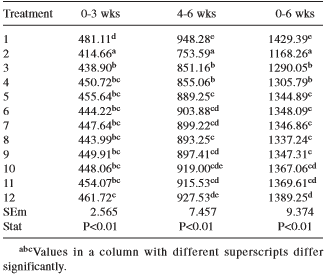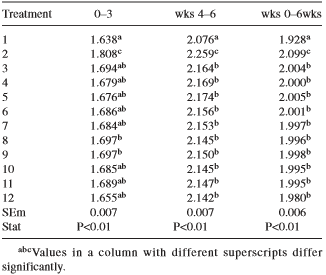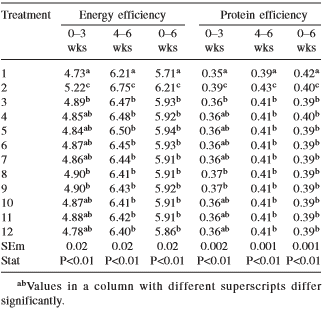Evaluation of the ability of adsorbents to ameliorate the adverse effects of aflatoxin B1 in broiler chickens
A study was carried out to investigate the efficacy of diatomaceous earth (DE), sodium bentonite (SB) and zeolite (Z), alone or in combinations as aflatoxin adsorbents in the diets of broiler chickens containing 300 ppb aflatoxin B1 (AFB1). Day-old broiler chicks (384) were divided into 12 treatment groups (T1, control; T2, T1 + 300 ppb AFB1; T3, T2 + 0.5% DE; T4, T2 + 1% DE; T5, T2 + 0.5% SB; T6, T2 + 1% SB; T7, T2 + 0.5% DE +0.5% SB; T8, T2 + 0.5% Z; T9, T2 + 1% Z; T10, T2 + 0.5% Z + 0.5% DE; T11, T2 + 0.5% Z + 0.5% SB; T12,T2 +[Z+DE+SB (0.33% each)]. Each diet was offered from day-old to 42 days of age to 4 replicated groups of 8 birds each. Feeding diet with 300 ppb of AFB1 in diet caused significant decrease in body weight gain (BWG 1168g) as compared to control (1 429 g). Inclusion of all the binders in aflatoxin contaminated diet, alone or in combinations, improved the overall BWG (1 290 to 1 389 g/bird), however, significantly lower BWG was recorded in DE groups in comparison to other binders during 0–6 weeks growth period. The BWG did not differ between zeolites and sodium bentonite groups. Feed consumption was not affected during the first week of age but reduced thereafter on diet with 300 ppb level of dietary AFB1. Amongst the binder groups, feed consumption was lowest in DE fed groups. Addition of aflatoxin resulted in poor feed conversion, energy and protein efficiency, which partially improved on inclusions of binders at any levels, alone or in combination. Thus, it may be concluded that addition of 300 ppb AFB1 in the diet of broiler chickens impaired the performance of broiler chickens during 0–6 weeks of age. All the 3 binders at 0.5 or 1% level, alone or in combination, were partially efficacious in ameliorating the adverse effects of aflatoxin. Among the binders tested, diatomaceous earth appeared to be the least efficacious in ameliorating aflatoxicosis in broiler chickens.
Key words: Adsorbent, Aflatoxin, Broiler chicken, Feed, Energy, Protein.






AOAC. 1990. Official Methods of Analysis. 15th edn. Association of Official Analytical Chemists, Washington, DC.
Beura C K, Johri T S, Sadagopan V R. and Panda, B K. 1993. Interaction of dietary protein level on dose-response relationship during aflatoxicosis in commercial broilers. Indian Journal of Poultry Science 28:170–77.
BIS. 2007. Bureau of Indian Standards (IS 1347: 2007). Poultry Feeds – Specification. (Fifth Revision).
Busby, W F and Wogan, G N. 1984. Aflatoxins. Chemical Carcinogenesis. pp. 945–1136. (Ed.) Searle C D. American Chemical Society, Washington, D.C., USA.
Coulombe R A. 1993. Biological action of mycotoxins. Journal of Dairy Science 76: 880–91.
Denli M, Okan F and Doran F. 2004. Effect of conjugated linoleic acid (CLA) on the performance and serum variables of broiler chickens intoxicated with aflatoxin B1. South African Journal of Animal Sciences 34: 97–103.
Doerr J A, Huff W E, Wabeck C J, Chaloupka G W, May J D and Merkley J W. 1983. Effects of low level chronic aflatoxicosis in broiler chickens. Poultry Science 62: 1971–77.
Doll S and Danicke S. 2004. In vitro detoxification of Fusarium toxins. Archives of Animal Nutrition 58: 419–41.
El-Husseiny O M, Abdallah A G, Abdel-Ltif K O. 2008. The influence of biological additives on broiler performance. International Journal of Poultry Science 7(9): 862–71.
Giambrone J J, Diener U L, Davis N D, Panangala V S and Hoerr F J. 1985. Effects of purified aflatoxin on broiler chickens. Poultry Science 64: 852–58.
Hoerr F J. 2003. Diseases of Poultry. Pp. 1103–92. (Ed.) Saif Y M. Iowa State University Press, Ames.
Johri T S, Agarwal R, Rashmi and Sadagopan V R. 1988. Response of pure bred broiler chicks to low dietary of aflatoxin. Proceedings of XII National Confernce and Symposium of IPSA. CARI, Izatnagar.
Kermanshahi H, Hazegh A R and Afali. 2009. Effect of sodium bentonite in broiler chickens fed diets contaminated with Aflatoxins B1. Journal of Animal and Veterinary Advances 8 (8): 1631–36.
Lopes J M, Rutz F, Mallmann C A, Toledo G S and Pinto. 2006. Utilization of sodium bentonite as adsorbent of aflatoxins in broiler feed. Ciência Rural 36: 1594–99.
Miazzo R, Rosa C A R, Dequeiroz-Carvalho E C, Mangoli C, Chiacchiera S M, Palacio G, Saenz M, Kikot A, Basaldella E and Dalcero A. 2000. Efficacy of synthetic of synthetic zeolite to reduce the toxicity of aflatoxin in broiler chicks. Poultry Science 79: 1–6.
Miazzo R, Peralta M F, Magnoli C, Salvano M, Ferrero S, Chiacchiera S M, Carvalho E C Q, Rosa C A R and Dalcero A. 2005. Efficacy of sodium bentonite as a detoxifier of broiler feed contaminated with aflatoxin and fumonisin. Poultry Science 84: 1–8
Modirsanei M, Mansoori B, Khosravi A R, Kiaei M M, Khazraeinia P, Farkhoy M and Masoumi Z. 2008. Effect of diatomaceous earth on the performance and blood variables of broiler chicks during experimental aflatoxicosis. Journal of the Science of Food and Agriculture 88: 622–32.
Oguz H, Kececi T, Birdane Y O, Onder F and Kurtoglu V. 2000. Effect of clinoptilolite on serum biochemical and haematological characters of broiler chickens during experimental aflatoxicosis. Research in Veterinary Science 69: 89–93.
Okan F, Denli M, Uluocak A N and Doran F. 2004. Effect of varying levels of aflatoxin B1 on the performance, egg quality characteristics and serum biochemical variables in laying quails (Coturnix coturnix japonica). November 25–27, Balnimalcon- 2004, Romania.
Pasha T N, Farooq M U, Khattak F M, Jabbar M A and Khan A D. 2007. Effectiveness of sodium bentonite and two commercial products as aflatoxin adsorbents in diets for broiler chickens. Animal Feed Science and Technology 132: 103–10.
Pons D, Cucullu A P, Lee L S, Robertson J A and Goldblatt L A. 1966. Determination of aflatoxins in agricultural products: Use of aqueous acetone for extraction. Journal of Analytical Chemistry 49: 544–52.
Raju M V L N and Devegowda G. 2000. Influence of esterified glucomannan on performance and organ morphology, serum biochemistry and hematology in broilers exposed to individual and combined mycotoxicosis (aflatoxin, ochratoxin and T–2 toxin). British Poultry Science 41: 640–50. Reddy R A,
Reddy,V R, Rao P V and Yadagiri B. 1982. Effect of experimentally induced aflatoxicosis on the performance of commercial broiler chicks. Indian Journal of Animal Sciences 52: 405–10.
Robens J F and Richard J L. 1992. Aflatoxins in animal and human health. Review of Environment Contamination 127: 69–94.
Rosa C A R, Miazzo R, Magnoli C, Salvano M, Chiacchiera S M, Ferrero S, Saenz M, Carvalho E C Q and Dalcero A. 2001. Evaluation of the efficacy of bentonite from the south of Argentina to ameliorate the toxic effects of aflatoxin in broilers. Poultry Science 80: 139–44.
Safameher A. 2008. Effects of clinoptilolite on performance, Biochemical parameters, Hepatic Lesions in Broiler Chickens during aflatoxicosis. Journal of Animal and Vetrinary Advances 7(4): 381–88.
Schiefer H B and Beasley V R. 1989. Trichothecene Mycotoxicosis: Pathophysiologic Effects. V. pp. 61–89. (Ed.) Beasley R. CRC Press, Boca Raton, FL.
Shotwell O L, Hesseltine C V, Stubblefield R D and Sorenson W G. 1996. Production of aflatoxin on rice. Applied Microbilogy 14: 425–29.
Singh R, Shrivastava H P and Shrivastav A K. 2010. Mycotoxin contamination in maize as poultry feed. Indian Journal of Poultry Science 45(1): 108–10.
Snedecor G W and Cochran W G. 1980. Statistical Methods. 6th edn. Iowa State University Press, Ames, Iowa.
Talapatra S K, Ray S C and Sen K C. 1940. Estimation of phosphorus, choline, calcium, magnesium, sodium and potassium in feeding stuffs. Indian Journal of Veterinary Science and Animal Husbandary 10: 243–45.
Verma J. 1994. ‘Studies on the effect of dietary aflatoxin, ochratoxin and their combinations on performance, energy and protein utilization in poultry.’ Ph. D. Thesis, submitted to Deemed University, IVRI, Izatnagar.
Wyatt R D. 1991. Poultry. pp 553–78. (Eds) Smith J and Henderson R S.








.jpg&w=3840&q=75)